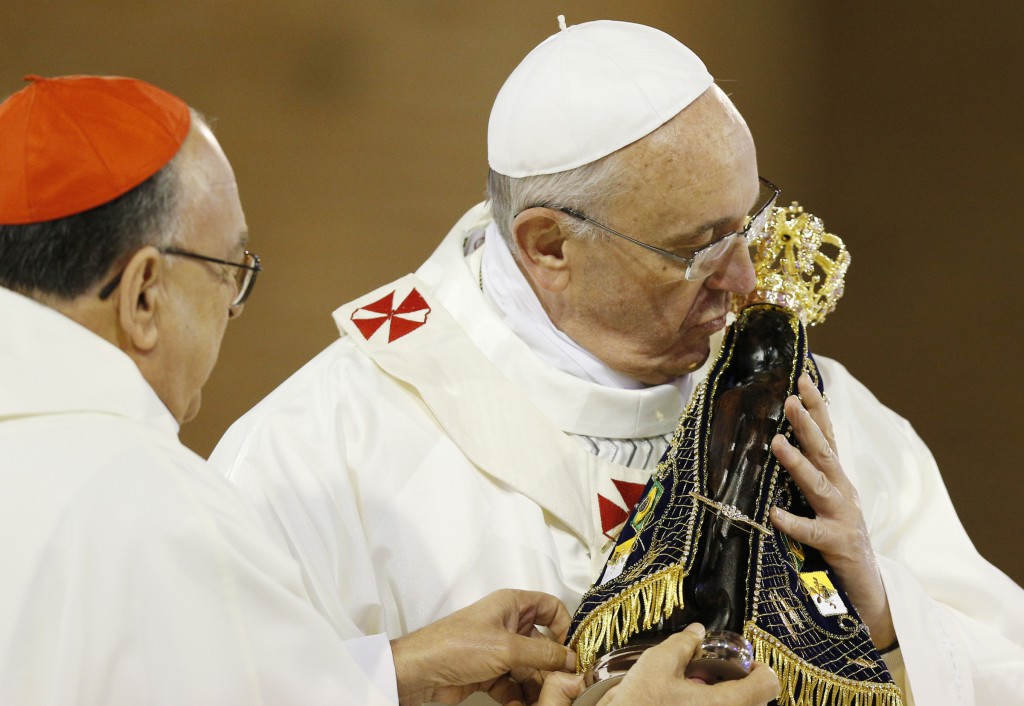
When Pope Francis went to the Marian shrine of Aparecida, he mentioned that some fishermen had found the statue of Our Lady that is venerated there. Can you tell me more about it? Did Our Lady appear?
The shrine of Aparecida has an interesting history dating back to the 18th century.
The word Aparecida, by the way, is the past participle of “appear” in Portuguese and Spanish.
The name was applied to a statue of Our Lady which had quite miraculously appeared.
According to the official account, in October 1717, Dom Pedro de Almeida, Count of Assumar and Governor of the Province of São Paulo and Minas Gerais, was passing through the area of Guaratinguetá, a small city in the Paraíba river valley near São Paulo, Brazil.
The local people decided to celebrate a feast in his honour with a banquet in which fish would be served.
Three fishermen then went out to fish on the river, haing prayed to Our Lady of the Immaculate Conception for a good catch as they had the custom of doing.
It should be noted that their devotion preceded the proclamation of the dogma of the Immaculate Conception by over 100 years (cf J Flader, Question Time 1, Connor Court 2012, q 32).
After many hours of fishing they had caught nothing and were very discouraged. They cast their nets once more and, instead of fish, hauled in a clay statue of Our Lady without its head.
One more cast netted the head of the statue. They washed the statue and recognised it as a dark-skinned representation of Our Lady of the Immaculate Conception.
They wrapped it in cloth and named it Nossa Senhora da Aparecida Conceição, Our Lady of the Conception which has Appeared.
The statue was less than a metre high and, after a long time in the water, had lost its polychrome colouring.
It is believed to have been made around 1650 by Fray Agostinho de Jesus, a monk from São Paulo known for his sacred images in clay.
Buoyed up by hope in the image they had found and having entrusted themselves once more to Our Lady, the fishermen went back to their fishing.
This time they were successful, filling their nets completely. They attributed the miraculous catch to Our Lady’s intercession.
One of the fishermen, Felipe Pedroso, took the statue to his home where his family and friends began to venerate it. For the next 15 years the statue remained in his home and devotion to Our Lady increased.
People were coming from far and wide, having heard of the many favours and miracles attributed to Our Lady.
The Pedroso family built a small chapel for the statue but this soon became too small for the many visitors. In 1732, the Pedrosos moved to Porto Iguassu, taking the statue with them.
There, a larger chapel was built on the Morro dos Coqueiros (Hill of the Palm Trees), and it was opened in 1745.
With the number of visitors increasing constantly, work on a larger church began in 1834. It was granted the title of Minor Basilica in 1908.
In 1904, the 50th anniversary of the proclamation of the dogma of the Immaculate Conception, the statue was adorned with a gold crown following a decree of Pope Pius X.
The statue at present is dark brown in colour and is clothed in a dark blue robe of richly embroidered cloth, with gold clasps. Only Our Lady’s face and hands can be seen.
In 1930, the Blessed Virgin Mary, under the title Our Lady of Aparecida, was proclaimed Queen and Principal Patroness of Brazil by Pope Pius XI.
In 1955, work began on the present Basilica, which is in the form of Greek cross and can hold up to 45,000 people.
It is the largest Marian temple and the second largest basilica in the world, second only to St Peter’s in Rome.
It was consecrated by Pope John Paul II in 1980 and given the title of Minor Basilica.
Due to the growth of the town of Aparecida and the importance of the shrine, the Holy See in 1958 created the new Archdiocese of Aparecida.
Since the 19th century, the feast of Our Lady Aparecida has been celebrated on October 12.
In Brazil, it is a holy day of obligation and, since Pope John Paul II’s visit to the country in June 1980, it has been a national public holiday.
Some five million pilgrims visit the shrine each year.